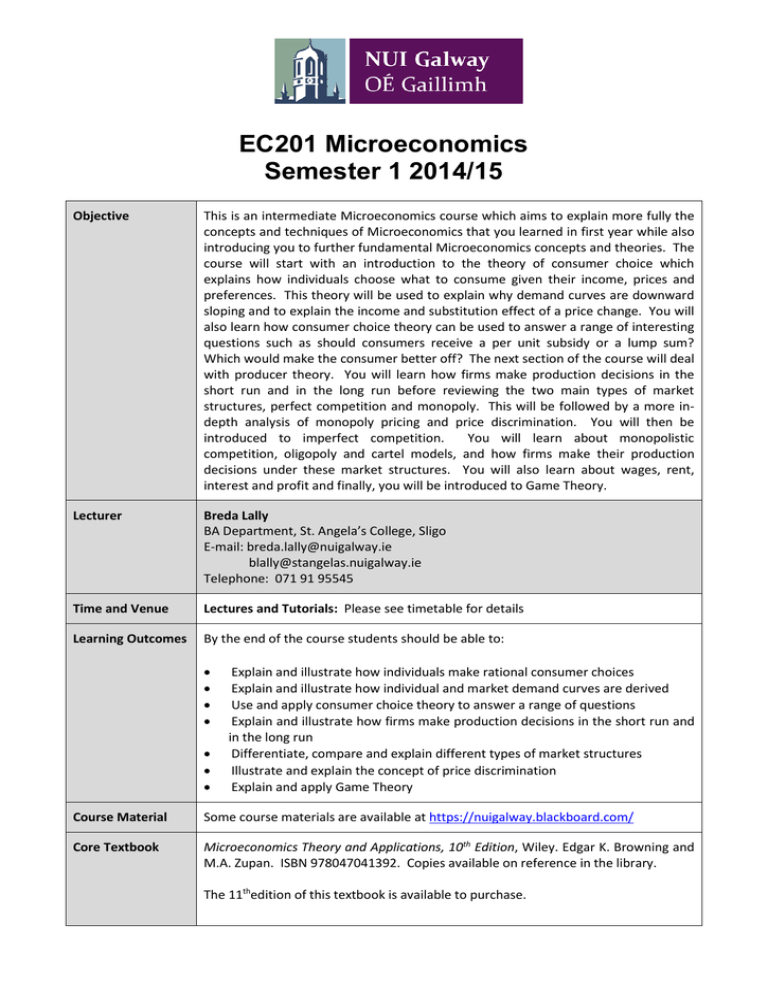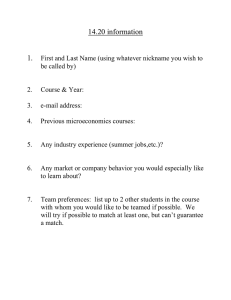EC201 Microeconomics Semester 1 2014/15
advertisement

EC201 Microeconomics Semester 1 2014/15 Objective This is an intermediate Microeconomics course which aims to explain more fully the concepts and techniques of Microeconomics that you learned in first year while also introducing you to further fundamental Microeconomics concepts and theories. The course will start with an introduction to the theory of consumer choice which explains how individuals choose what to consume given their income, prices and preferences. This theory will be used to explain why demand curves are downward sloping and to explain the income and substitution effect of a price change. You will also learn how consumer choice theory can be used to answer a range of interesting questions such as should consumers receive a per unit subsidy or a lump sum? Which would make the consumer better off? The next section of the course will deal with producer theory. You will learn how firms make production decisions in the short run and in the long run before reviewing the two main types of market structures, perfect competition and monopoly. This will be followed by a more indepth analysis of monopoly pricing and price discrimination. You will then be introduced to imperfect competition. You will learn about monopolistic competition, oligopoly and cartel models, and how firms make their production decisions under these market structures. You will also learn about wages, rent, interest and profit and finally, you will be introduced to Game Theory. Lecturer Breda Lally BA Department, St. Angela’s College, Sligo E-mail: breda.lally@nuigalway.ie blally@stangelas.nuigalway.ie Telephone: 071 91 95545 Time and Venue Lectures and Tutorials: Please see timetable for details Learning Outcomes By the end of the course students should be able to: Explain and illustrate how individuals make rational consumer choices Explain and illustrate how individual and market demand curves are derived Use and apply consumer choice theory to answer a range of questions Explain and illustrate how firms make production decisions in the short run and in the long run Differentiate, compare and explain different types of market structures Illustrate and explain the concept of price discrimination Explain and apply Game Theory Course Material Some course materials are available at https://nuigalway.blackboard.com/ Core Textbook Microeconomics Theory and Applications, 10th Edition, Wiley. Edgar K. Browning and M.A. Zupan. ISBN 978047041392. Copies available on reference in the library. The 11thedition of this textbook is available to purchase. Students should also consult the Student Companion Website for this book at: http://bcs.wiley.com/hebcs/Books?action=index&itemId=1118065549&bcsId=6672 It is a useful learning resource, where you can access Powerpoint slides and other useful online resources. Students may also find their first year textbook, Economics, useful for some topics. It is important that you read the core textbook in conjunction with the lecture notes presented in class. Relying on lecture notes alone is not sufficient. Assessment End of year Written Examination (2 hours) Two In-class tests (7th October and 18th November) Workload Hours Credit weighting Lecture hours Tutorials Written examination In-class tests Practice assignments and independent study Total workload 5 ECTS 36 hours 24 hours 2 hours 2 hours 36 hours 100 hours Course Outline Topic Chapter Theory of Consumer Choice Chapter 3 Individual and Market Demand Chapter 4 Using Consumer Choice Theory Chapter 5 The Theory of Production Chapter 7 Production Costs Chapter 8 Perfect Competition/Monopoly (Recap) Chapter 9/11 Product Pricing with Monopoly Power Chapter 12 Monopolistic Competition and Oligopoly Chapter 13 Game Theory and the Economics of Information Chapter 14 Wages, Rent, Interest and Profit Chapter 17 75% 25%


